- Author: Kathy Keatley Garvey
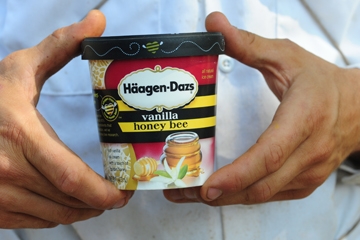
Häagen-Dazs has come up with a creative way to do so and it involves downloading a free concerto timer app on your I-Phone or I-Pad, pointing it at the lid of the brand's ice cream, and listening to a two-minute concerto until the ice cream is softened or tempered.
Two minutes is perfect for allowing the ice cream to soften or temper, the ice cream specialists say.
For every download of the concerto timer, Häagen-Dazs will donate $5 toward UC Davis bee research, up to $75,000.
Häagen-Dazs, in announcing (Aug. 8) the introduction of the Häagen-Dazs Concerto Timer app, described it as "the first iOS mobile app to integrate detailed 3D Kinect technology and video data that delivers a cutting edge augmented reality experience."
According to a press release, “The Concerto Timer app features two-minute-long music concertos that help consumers understand the exact amount of time needed to prepare their Häagen-Dazs ice cream in order to get the full, rich consistency and allow all the flavors to fully bloom. Allowing the ice cream to soften slightly – also called tempering – for two minutes enhances the texture and exposes fans to the craftsmanship of premium ingredients that is characteristic of Häagen-Dazs ice cream, gelato, sorbet and frozen yogurt."

Said Cady Behles, Häagen-Dazs brand manager: “The app concept came directly from our brand loyalists who recognized the necessity of tempering to enjoy all of the flavors in our ice cream. We took their feedback and developed an advanced mobile experience – something never seen before in the ice cream industry – that would be functional and also entertain them during the optimal time period.”
"Traditionally, augmented reality technology has involved flat video or low polygon 3D objects with a very limited and robotic range of motion," according to the news release. "Unlike other augmented reality apps, the Concerto Timer app integrates detailed 3D Kinect and video data."
"The app captures the nuances of the real violin and cello performances, enhanced with expressive particles, resulting in an ethereal and unique creative style. This approach allows the musicians to move with a fluid natural motion in 3D space."
"Developed by creative agency Goodby Silverstein & Partners and digital production company JAM3, the Häagen-Dazs Concerto Timer app is now available for download in the iTunes App Store."
Some 50 percent of Häagen-Dazs flavors are honey-bee dependent. “Honey bee colonies – which are responsible for one third of the world’s food supply — are dying at an alarming rate, posing a serious risk to our natural food supply, including many of the ingredients that define Häagen-Dazs ice cream,” according to the press release.
Häagen-Dazs has a long partnership with UC Davis. It launched the Häagen-Dazs Honey Bee Haven, a half-acre bee friendly garden that was planted in 2009 next to the Laidlaw facility. The brand also funded Häagen-Dazs Postdoctoral Fellow, Michelle Flenniken, an insect virus researcher formerly based at UC San Francisco. She is now a research assistant professor in the Department of Plant Sciences and Plant Pathology, Montana State University.
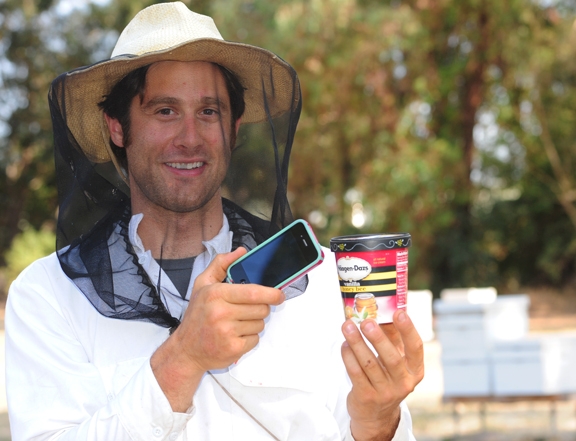
- Author: Kathy Keatley Garvey
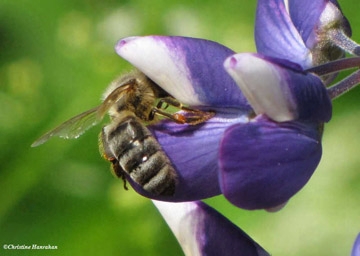
Compliments of Häagen-Dazs, the wildflowers will be on a quarter-acre site adjacent to the soon-to-be-implemented Häagen-Dazs Honey Bee Haven, near the Harry H. Laidlaw Jr. Honey Bee Research Facility.
The Campus Buzzway, coordinated by the Department of Entomology and the California Center for Urban Horticulture, will begin blooming in the spring.
The Häagen-Dazs Honey Bee Haven, a half-acre bee friendly garden scheduled to be planted in mid-October, is designed to serve as a year-around food source for honey bees, raise public awareness about the plight of honey bees and encourage visitors to plant bee-friendly gardens of their own, said entomologist Lynn Kimsey, professor and vice chair of the Department of Entomology and director of the Bohart Museum of Entomology.
“The Campus Buzzway will be a fabulous addition to the honey bee garden already under construction at our Bee Biology facility,” Kimsey said. “Both will greatly benefit our colonies and make terrific teaching opportunities.”
Dave Fujino, executive director of the California Center for Urban Horticulture, said the Campus Buzzway will boast year-round blooms and vibrant colors. “The Buzzway will transform an empty field into something beautiful and functional,” he said. “Most importantly, the flower mix will have a positive impact on the health and wellness of our local pollinator populations.”
The Queen Bee Blend is an assortment of California poppy, coreopsis (also called tickseed) and wild perennial lupine. Blue and gold are the official UC Davis colors.
The blend will offer “a long blooming season that provides food for bees all year long,” said Diane McIntyre, senior public relations manager of Haagen-Dazs.
Fujino said that the Campus Buzzway, spanning approximately 9000 square feet, will include wildflower liners and weed barriers to “provide a uniform, weed-free field of flowers for next spring.”
The Campus Buzzway was part of a national campaign, “A World Without Bees,” that Häagen-Dazs launched on college campuses in April. Students at 12 major colleges, including UC Davis, sampled the premier ice cream and voted on their favorite flower blend. The winner: the Queen Bee Blend.
Häagen-Dazs is in its second year of a national campaign to raise funds for honey bee research at UC Davis and Penn State University. Part of the brand's donations to UC Davis are being used to create the Haagen-Dazs Honey Bee Haven and the Campus Buzzway.
Honey bees are responsible for the pollination of more than 100 crops in the United States, including fruits, vegetables, nut and seeds, said Extension Apiculturist Eric Mussen of the UC Davis Department of Entomology faculty and a member of the Häagen-Dazs scientific board. Nearly half of all Häagen-Dazs flavors depend on bee pollination.
The Häagen-Dazs Honey Bee Haven design is the work of a four-member Sausalito team: landscape architects Donald Sibbett and Ann F. Baker, interpretative planner Jessica Brainard and exhibit designer Chika Kurotaki. They won the internationally publicized competition earlier this year.
Sibbett is a principal with the Sibbett Group; Baker is a senior landscape architect with RRM Design Group; Brainard is an independent museum consultant; and Kurotaki is an exhibit designer who works for RRM Design Group.
The Sausalito team's design zeroed in on sustainability and visitor experience. The four interconnected gardens, “Honeycomb Hideout,” “Nectar Nook,” “Pollinator Patch” and “My Backyard” form the “physical and interpretive framework for our honey bee haven design,” the authors said. A series of trails connect the gardens. Trellises define the entry ways and reinforce the passage to the next space.
Incorporated into each of the four sections are gathering spaces that serve as orientation points for guided tours, facilitated programs and ‘chat time' with beekeepers and entomologists,” the team explained. Identification labels will help visitors know more about the plants, or what they can plant in their own yards.
The design also includes a “Learning Center” building and paths labeled “Orchard Alley,” “Save the Bee Sanctuary,” “Round Dance Circle” and “Waggle Dance Way.”
Häagen-Dazs ice cream committed $125,000 to the UC Davis Department of Entomology for the garden project. This encompasses site planning, preparation and the design competition.
Said design competition coordinator Melissa “Missy” Borel, program manager for the California Center for Urban Horticulture: “We'll not only be providing a pollen and nectar source for the millions of bees on Bee Biology Road, but we will also be demonstrating the beauty and value of pollinator gardens. My hope is that it will inspire everyone to plant for pollinators!”
A public opening of the Häagen-Dazs Honey Bee Haven and Campus Buzzway is tentatively scheduled in the fall of 2010.
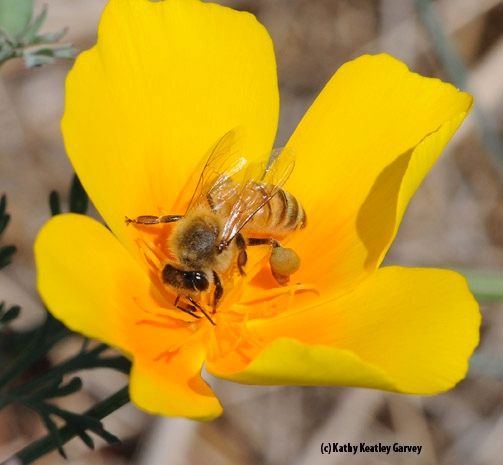
- Author: Kathy Keatley Garvey
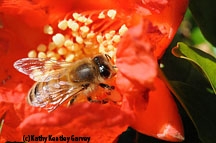
Häagen-Dazs has announced that it is making a $125,000 donation to the UC Davis Department of Entomology to launch a nationwide design competition to create a one-half acre Honey Bee Haven garden at the Harry H. Laidlaw Jr. Honey Bee Research Facility at UC Davis.
From that gift, $65,000 will be used to establish the garden.
Häagen-Dazs and UC Davis will determine how the balance of the gift can best be used to benefit the health of honey bee populations.
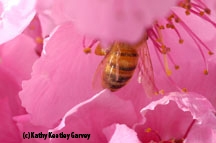
The garden will include a seasonal variety of blooming plants that will provide a year-round food source for honey bees. It is intended to be a living laboratory supporting research into the nutritional needs and natural feeding behaviors of honey bees and other insect pollinators.
Visitors to the garden will be able to glean ideas on how to establish their own bee-friendly gardens and help to improve the nutrition of bees in their own backyards. The bee haven is expected to be the first in a series of pollinator gardens at UC Davis.
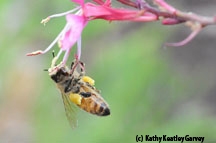
"Campus visitors will be able to see which flowers are most attractive to foraging honey bees and how to space the flowers in order to have bees flying in the most convenient areas of their gardens," he added.
Garden Design Competition
The garden design competition funded by the Häagen-Dazs brand is being coordinated by the California Center for Urban Horticulture at UC Davis. It is open to anyone who can create a proposal by using basic landscape design principles.
"This is an excellent opportunity to raise public awareness of the current plight of honey bees and to educate the public on how they can help," said Dave Fujino, director of the California Center for Urban Horticulture. "Planting a garden with honey bee friendly plants provides nutrition for the bees and has the potential to create valuable habitat corridors between agricultural sites."
Design submissions for the competition should describe a one-half-acre garden that can be installed for $65,000 or less. Submissions must include a site plan, planting plan, maintenance program and construction cost estimate.
The plans should include plant species that provide forage for honey bees, a bee-accessible water source, and environmentally friendly paths for visitors. More design specifications and lists of bee-appropriate plants can be found at the UC Davis Department of Entomology Web site.
Design plans for the Honey Bee Haven garden must be received at UC Davis by Jan. 30, 2009. Plans should be mailed to the California Center for Urban Horticulture, College of Agricultural and Environmental Sciences Dean's Office, University of California, One Shields Ave., Davis, CA 95616-8571.
The winning design, to be announced in February 2009, will be implemented, and the winning team will receive on-site recognition on the Häagen-Dazs commemorative plaque located within the garden. In addition, the winner will receive a free year's supply of Häagen-Dazs ice cream and will be included in a 2009 press announcement.
More information on the design competition can be obtained from Melissa Borel, program manager at UC Davis' California Center for Urban Horticulture, at (530) 752-6642.
Honey Bee Disappearance
Honey bees, which pollinate more than 100 different U.S. agricultural crops, valued at $15 billion, are dying from an unexplained phenomenon known as colony collapse disorder. First identified three years ago, the disorder is characterized by hive abandonment. The bees disappear, often leaving behind the honey and the immature bees, which die if not fed by the worker bees. In recent years, the nation's beekeepers have reported losing from one-third to all of their bees.
Bee experts suspect that a multitude of causes, including pesticides, diseases, parasites, stress, climate change and malnutrition, are contributing to the dramatic decline in honey bee populations.
Seasonal food shortages lead to malnutrition in the bees, making them more susceptible to diseases.
The Häagen-Dazs brand in February of this year launched the "Häagen-Dazs Loves Honey Bees" campaign. The company committed a combined $250,000 donation for bee research to UC Davis and Pennsylvania State University. It also formed a seven-member scientific advisory board, created an educational Web site and introduced the new Vanilla Honey Bee ice cream flavor.
During the last several months, the public has generously responded to the Häagen-Dazs brand's call to action by donating more than $30,000 to support honey bee research at UC Davis. In addition, numerous companies have launched programs that are donating a percentage of their sales to support UC Davis honey bee research. For example, Whole Foods Markets generated more than $10,600 in direct and matching gifts through its in-store promotions.
Anyone interested in donating to UC Davis honey bee research may obtain information at this UC Davis site.
About UC Davis
 For 100 years, UC Davis has engaged in teaching, research and public service that matter to California and transform the world. Located close to the state capital, UC Davis has 31,000 students, an annual research budget that exceeds $500 million, a comprehensive health system and 13 specialized research centers. The university offers interdisciplinary graduate study and more than 100 undergraduate majors in four colleges — Agricultural and Environmental Sciences, Biological Sciences, Engineering, and Letters and Science — and advanced degrees from five professional schools: Education, Law, Management, Medicine, and Veterinary Medicine. The UC Davis School of Medicine and UC Davis Medical Center are located on the Sacramento campus near downtown.—Pat Bailey and Kathy Keatley Garvey
For 100 years, UC Davis has engaged in teaching, research and public service that matter to California and transform the world. Located close to the state capital, UC Davis has 31,000 students, an annual research budget that exceeds $500 million, a comprehensive health system and 13 specialized research centers. The university offers interdisciplinary graduate study and more than 100 undergraduate majors in four colleges — Agricultural and Environmental Sciences, Biological Sciences, Engineering, and Letters and Science — and advanced degrees from five professional schools: Education, Law, Management, Medicine, and Veterinary Medicine. The UC Davis School of Medicine and UC Davis Medical Center are located on the Sacramento campus near downtown.—Pat Bailey and Kathy Keatley Garvey
Media contacts:
* Lynn Kimsey, chair, UC Davis Department of Entomology, (530) 752-5373, lskimsey@ucdavis.edu
* Eric Mussen, apiculturist, Harry H. Laidlaw Jr. Honey Bee Research Facility, (530) 752-0472, ecmussen@ucdavis.edu
* Dave Fujino, director, California Center for Urban Horticulture, (530) 754-7739, dwfujino@ucdavis.edu
* Pat Bailey, UC Davis News Service staff, (530) 752-9843, pjbailey@ucdavis.edu
* Kathy Keatley Garvey, communications specialist, UC Davis Department of Entomology, (530) 754-6894, kegarvey@ucdavis.edu
- Author: Kathy Keatley Garvey

“We're hoping that Michelle Flenniken's expertise in molecular virology will lead to understanding one of the factors contributing to colony collapse disorder and lead to strategies that increase honeybee survival,” said Lynn Kimsey, chair of the Department of Entomology and director of the Bohart Museum of Entomology.
Colony collapse disorder occurs when bees mysteriously abandon their hives, often leaving the brood (immature bees) and honey. The nation's beekeepers have reported losing from one-third to 100 percent of their bees over the last two years.
Flenniken works with insect viruses in the laboratory of professor Raul Andino at UCSF. She will continue working in the lab and also with researchers at the Harry H. Laidlaw Jr. Honey Bee Research Facility at UC Davis.
Skilled in multidisciplinary research--molecular biology, microbiology, chemistry and cell biology—Flenniken will focus on the biology of honeybee viruses, specifically the role of RNA interference (RNAi) in the honeybee antiviral immune responses, Kimsey said.
RNA, short for ribonucleic acid, carries genetic information of viruses. RNAi is a mechanism that inhibits gene expression.
“I hypothesize that RNAi can be used as an antiviral strategy in honey bees,” Flenniken said. She will investigate the role of the RNAi machinery in virus infection and attempt to limit virus production in the bees by priming their RNAi machinery with viral specific double-stranded RNA. Flenniken has been identifying the viruses present in the hives of San Francisco Hobby Beekeepers and research collaborators.
“Most bees have viruses, particularly common is Kashmir bee virus,” said UC Davis apiculturist Eric Mussen. “In fact, we'd be surprised to find a bee not carrying some type of virus.”
In addition to Kashmir bee virus, Flenniken hopes to investigate deformed wing virus, sacbrood virus, acute bee paralysis virus, chronic bee paralysis virus, black queen cell virus, and Israeli acute paralysis virus.
Her parents completed a beekeeping course at Iowa State University and gifted her with the equipment, including a hat and veil, bee brush, hive tool and “a lot of good beekeeping books,” she said.
“I think bees are really interesting and look forward to learning more about them. I am really excited about this research topic because it encompasses molecular biology, ecology, environmental science, and global food production and health. “
A native of Nevada, Iowa, Flenniken received her bachelor's degree in biology and a minor in chemistry in 1998 at the University of Iowa, Iowa City, and her doctorate in microbiology in 2006 from Montana State University, Bozeman. She wrote her thesis on “Protein Cage Architectures for Targeted Therapeutic and Imaging Agent Delivery.”
In 1998-2000, she served as a Peace Corps volunteer in Ghana, West Africa, where she grew a variety of tree seedlings for an agro-forestry program. She participated in a study abroad program at Lancaster (England) University in 1996-97.
Flenniken is supported by an A. P. Giannini Foundation Postdoctoral Fellowship (April 2008) for her work in RNAi. Her graduate work was supported by the Ruth L. Kirschstein National Research Service Award from the National Institutes of Health; and the Louis V. and Norma Smith Fellowship, Department of Microbiology, Montana State University.
Häagen-Dazs last February gifted UC Davis with $100,000 to address the bee population decline. The funds will benefit sustainable pollination research, target colony collapse disorder, and support a postdoctoral researcher. Flenniken plans to use this funding for honeybee research supplies and conference attendance.
Häagen-Dazs also launched a Web site and created an advisory board that includes UC Davis and University of Pennsylvania bee specialists. UC Davis members are Mussen, bee breeder-geneticist Susan Cobey and Michael Parrella, professor of entomology and associate dean, College of Agricultural and Environmental Sciences.
The board advises company officials on scientific issues; announces new research findings; and educates the public on ways to help save the honey bee.
Mussen noted that honey bees are responsible for pollinating more than 100 U. S. crops, including fruits, vegetables, nuts and seeds. One-third of the American diet is pollinated by honey bees.



